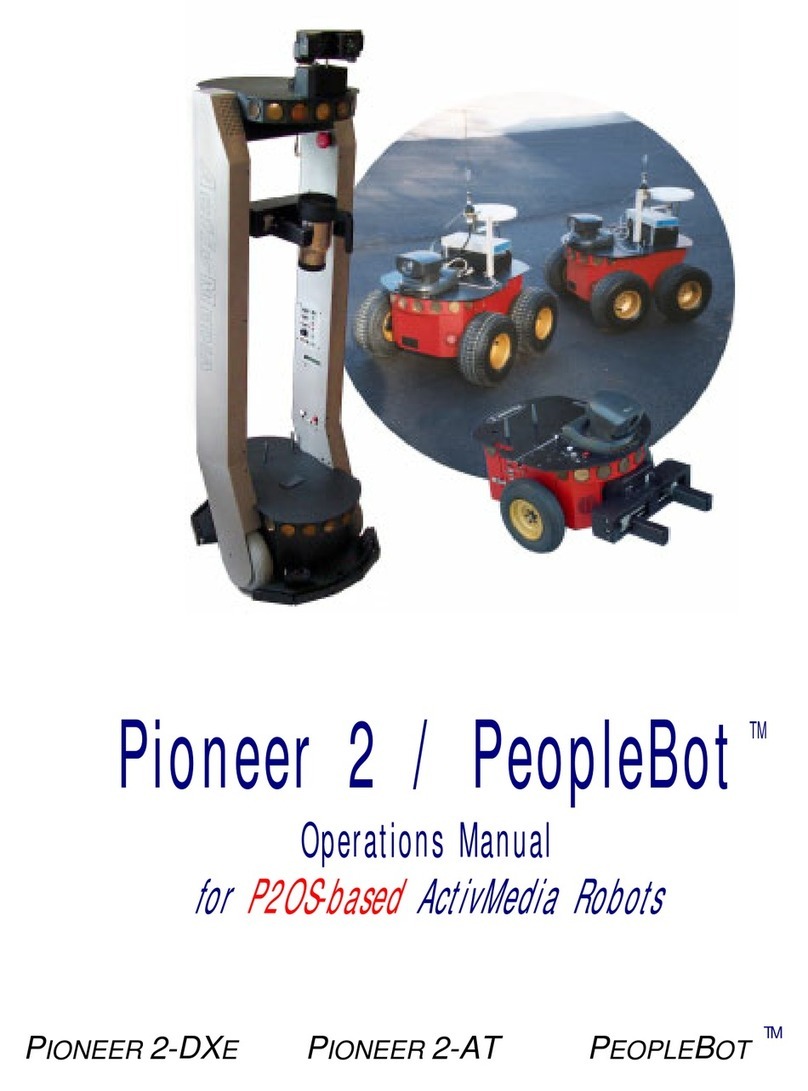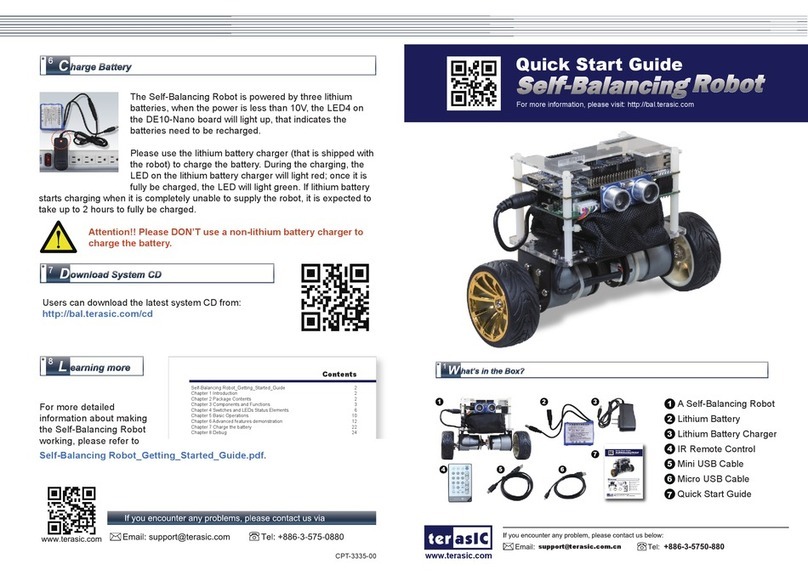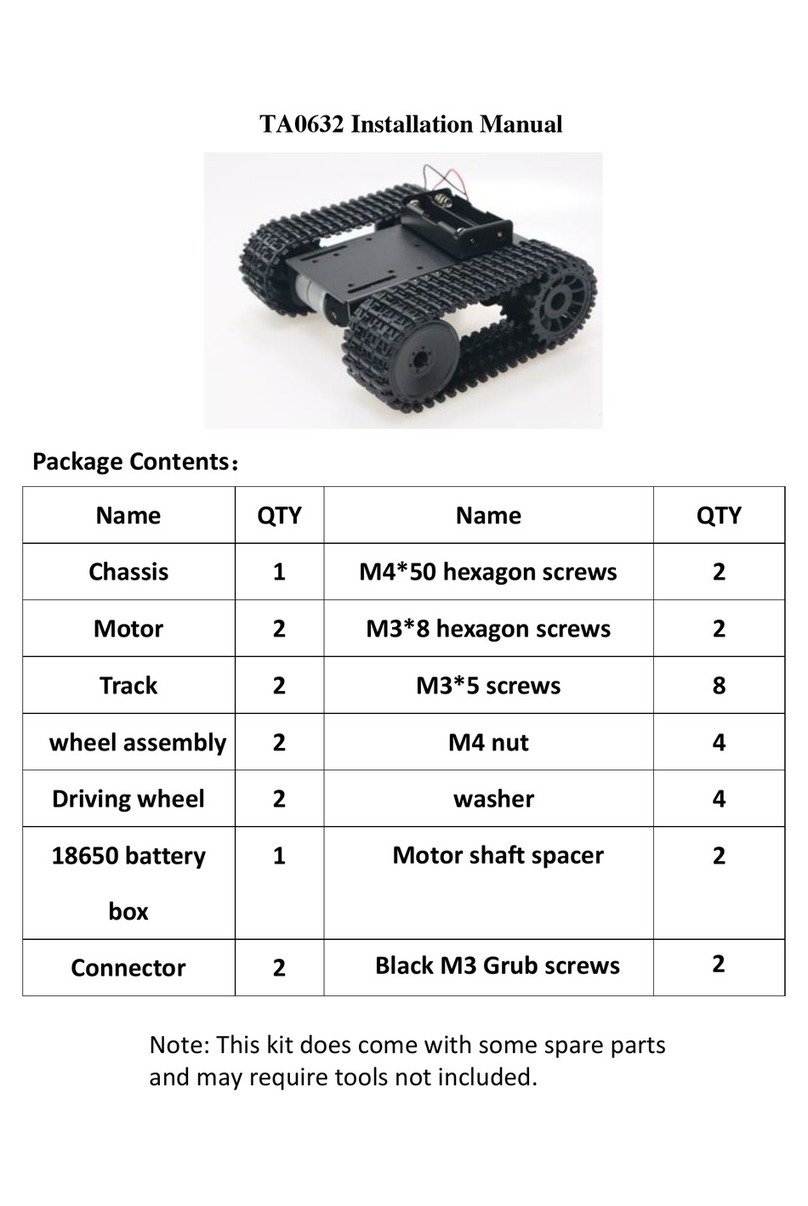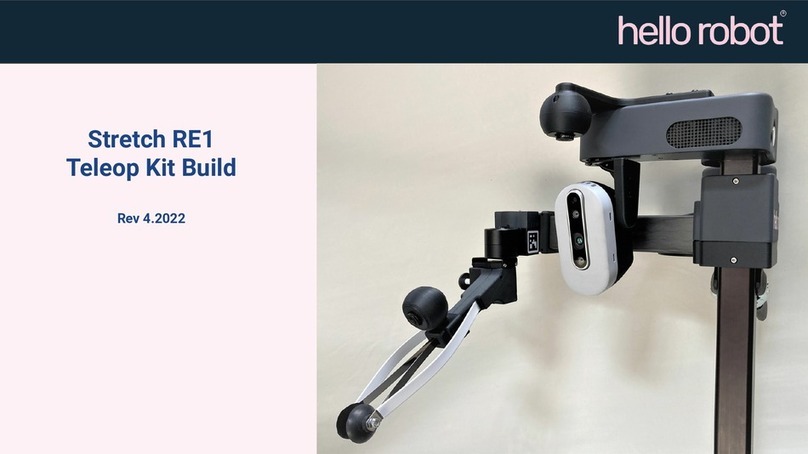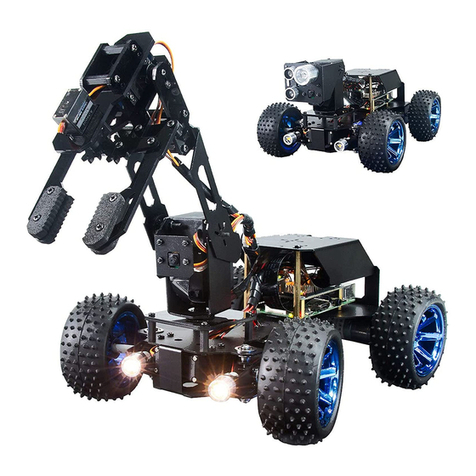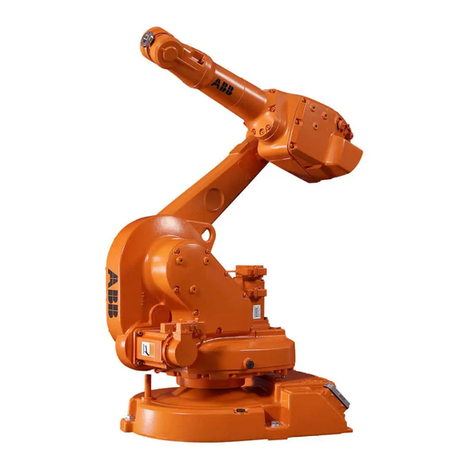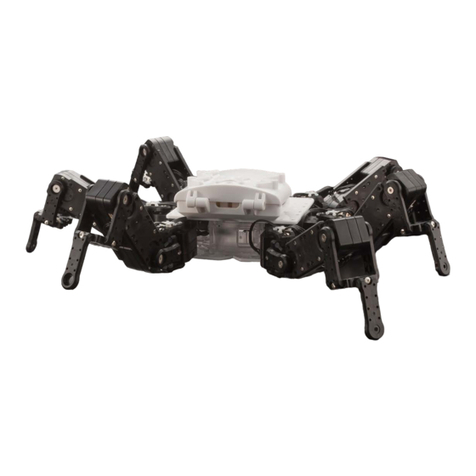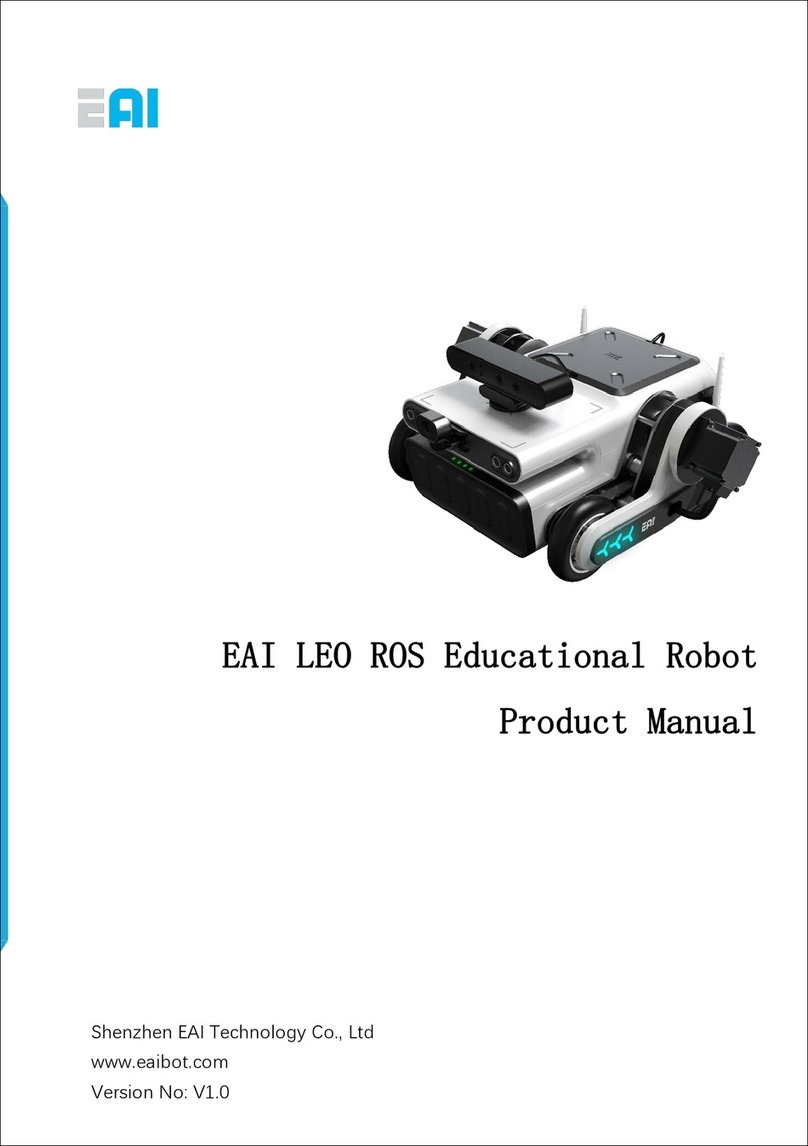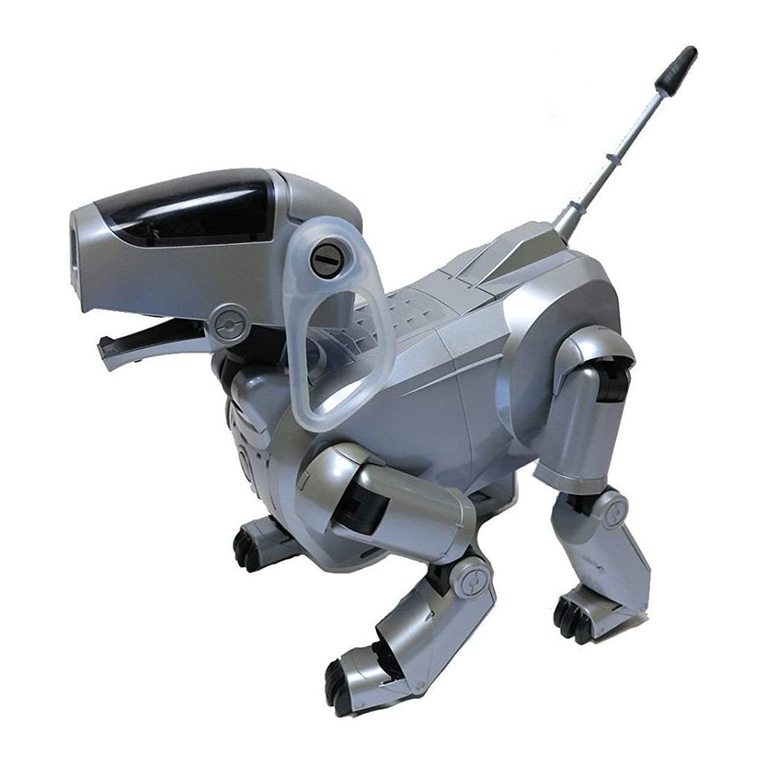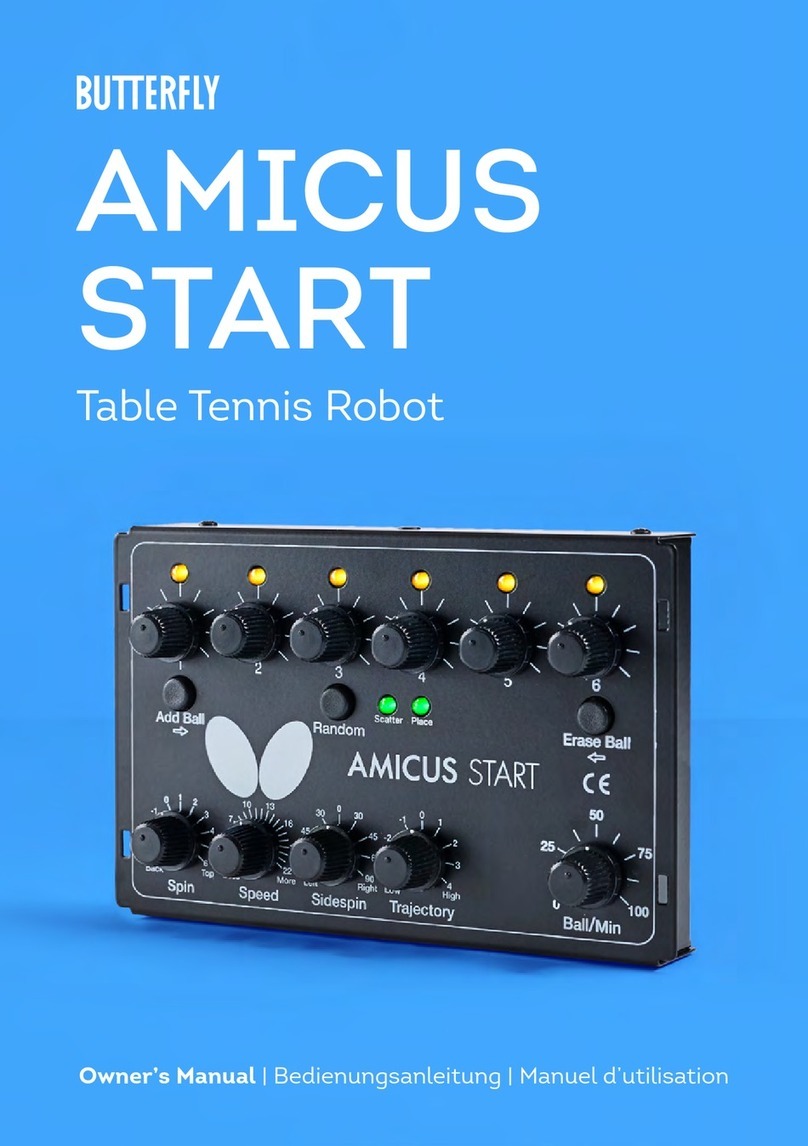SEW-Eurodrive MAXOLUTION MAXO-RPS-.-R Series User manual

*25797530_0418*
Drive Technology \ Drive Automation \ System Integration \ Services
Assembly and Operating
Instructions
MAXOLUTION® Production Robot
Parallel Arm Kinematics Kit
MAXO-RPS-.-R...-..-...-..
Edition 04/2018 25797530/EN

SEW-EURODRIVE—Driving the world

Table of contents
Assembly and Operating Instructions – Parallel Arm Kinematics Kit 3
Table of contents
1 General information.................................................................................................................. 5
1.1 About this documentation ...............................................................................................5
1.2 Structure of the safety notes ...........................................................................................5
1.3 Rights to claim under limited warranty ............................................................................6
1.4 Applicable documentation...............................................................................................6
1.5 Product names and trademarks......................................................................................7
1.6 Copyright notice ..............................................................................................................7
2 Safety notes .............................................................................................................................. 8
2.1 Preliminary information ...................................................................................................8
2.2 Working on the system solution ......................................................................................8
2.3 Target group ...................................................................................................................8
2.4 Designated use ...............................................................................................................9
2.5 Risk assessment and risk reduction ...............................................................................9
2.6 Verification ....................................................................................................................10
2.7 Transport.......................................................................................................................10
2.8 Setup and installation....................................................................................................10
2.9 Electrical installation .....................................................................................................10
2.10 Protective separation ....................................................................................................11
2.11 Startup and operation ...................................................................................................11
2.12 Inspection and maintenance .........................................................................................12
3 Application .............................................................................................................................. 13
3.1 Description ....................................................................................................................13
3.2 Type designation...........................................................................................................14
3.3 Configuration.................................................................................................................14
3.4 Scope of delivery ..........................................................................................................17
3.5 Control and visualization...............................................................................................18
3.6 Mechanical components ...............................................................................................19
4 Assembly and installation ..................................................................................................... 26
4.1 General information ......................................................................................................26
4.2 Mechanical installation..................................................................................................26
4.3 Electrical installation .....................................................................................................27
4.4 Sequence......................................................................................................................29
4.5 Procedure .....................................................................................................................30
5 Startup ..................................................................................................................................... 31
5.1 General information ......................................................................................................31
5.2 MOVIKIT® Robotics......................................................................................................31
5.3 Hardware startup ..........................................................................................................32
5.4 Referencing...................................................................................................................32
5.5 Software startup............................................................................................................37
5.6 Robot program ..............................................................................................................42
5.7 Control via the process controller .................................................................................49
6 Operation................................................................................................................................. 52
6.1 General information ......................................................................................................52
25797530/EN – 04/2018

Table of contents
Assembly and Operating Instructions – Parallel Arm Kinematics Kit
4
6.2 Operating modes ..........................................................................................................52
7 Service..................................................................................................................................... 53
7.1 Electronics service from SEW‑EURODRIVE ................................................................53
7.2 Waste disposal..............................................................................................................53
8 Inspection and maintenance ................................................................................................. 54
9 Technical data......................................................................................................................... 55
10 MAXOLUTION® Competence Center ..................................................................................... 56
25797530/EN – 04/2018

1
General information
About this documentation
Assembly and Operating Instructions – Parallel Arm Kinematics Kit 5
1 General information
1.1 About this documentation
The current version of the documentation is the original.
This documentation is an integral part of the product. The documentation is written for
all employees who assemble, install, start up, and service this product.
Make sure this documentation is accessible and legible. Ensure that persons respons-
ible for the machinery and its operation as well as persons who work on the product
independently have read through the documentation carefully and understood it. If you
are unclear about any of the information in this documentation or require further in-
formation, contact SEW‑EURODRIVE.
1.2 Structure of the safety notes
1.2.1 Meaning of signal words
The following table shows the grading and meaning of the signal words for safety
notes.
Signal word Meaning Consequences if disregarded
DANGER Imminent hazard Severe or fatal injuries
WARNING Possible dangerous situation Severe or fatal injuries
CAUTION Possible dangerous situation Minor injuries
NOTICE Possible damage to property Damage to the product or its envir-
onment
INFORMATION Useful information or tip: Simplifies
handling of the product.
1.2.2 Structure of section-related safety notes
Section-related safety notes do not apply to a specific action but to several actions
pertaining to one subject. The hazard symbols used either indicate a general hazard
or a specific hazard.
This is the formal structure of a safety note for a specific section:
SIGNAL WORD
Type and source of hazard.
Possible consequence(s) if disregarded.
• Measure(s) to prevent the hazard.
Meaning of the hazard symbols
The hazard symbols in the safety notes have the following meaning:
Hazard symbol Meaning
General hazard
25797530/EN – 04/2018

1General information
Rights to claim under limited warranty
Assembly and Operating Instructions – Parallel Arm Kinematics Kit
6
Hazard symbol Meaning
Warning of dangerous electrical voltage
Warning of hot surfaces
Warning of risk of crushing
Warning of suspended load
Warning of automatic restart
1.2.3 Structure of embedded safety notes
Embedded safety notes are directly integrated into the instructions just before the de-
scription of the dangerous action.
This is the formal structure of an embedded safety note:
SIGNAL WORD Type and source of hazard. Possible consequence(s) if disreg-
arded. Measure(s) to prevent the hazard.
1.3 Rights to claim under limited warranty
Read the information in this documentation. This is essential for fault-free operation
and fulfillment of any rights to claim under limited warranty. Read the documentation
before you start working with the product.
1.4 Applicable documentation
Observe the following other applicable documentation:
• Documentation of the robot mechanics
• "Synchronous CMP Servomotors" operating instructions
• "MOVIDRIVE®system Application Inverters" operating instructions
• "MOVIDRIVE®modular Application Inverters" operating instructions
• "MOVIDRIVE® modular – Power Supply Module with External DC Link Supply" ad-
dendum to the operating instructions
• "MOVI-C® CONTROLLER power UHX85A and power eco UHX84A" manual
• "MOVI-C® CONTROLLER power with PROFINET IO Interface" manual
Always use the latest edition of documentations and software.
25797530/EN – 04/2018

1
General information
Product names and trademarks
Assembly and Operating Instructions – Parallel Arm Kinematics Kit 7
The SEW‑EURODRIVE website (www.sew‑eurodrive.com) provides a wide selection
of documents for download in various languages. If required, you can also order prin-
ted and bound copies of the documentation from SEW‑EURODRIVE.
1.5 Product names and trademarks
The brands and product names in this documentation are trademarks or registered
trademarks of their respective titleholders.
1.6 Copyright notice
©2018SEW‑EURODRIVE. All rights reserved. Unauthorized reproduction, modifica-
tion, distribution or any other use of the whole or any part of this documentation is
strictly prohibited.
25797530/EN – 04/2018

2Safety notes
Preliminary information
Assembly and Operating Instructions – Parallel Arm Kinematics Kit
8
2 Safety notes
2.1 Preliminary information
The following basic safety notes must be read carefully to prevent injury to persons
and damage to property.
The safety notes refer to the use of the system solution described in this document.
This document does not replace the detailed documentation of the products and soft-
ware used. You therefore have to observe the documentation of the products and soft-
ware used.
Ensure that all safety notes are observed.
2.2 Working on the system solution
Make sure that all work steps described in this documentation are only performed by
qualified specialists.
Observe the following:
• National and regional safety and accident prevention regulations
• Personal protective equipment, e.g. safety shoes
• Caution signs on the products
• All system-specific specifications and conditions
The system solution may only be operated in systems equipped with the required
monitoring and protection devices.
2.3 Target group
Planning and
design
Any work related to planning and design which is necessary for the correct integration
of the drive solution into the machine/system may only be performed by adequately
qualified personnel. Qualified personnel in the context of this documentation are per-
sons familiar with the mechanical or electromechanical design, integration of the drive
solution into the plant/machine and the corresponding processes (e.g. hazard analysis
and risk assessment) and who have the following qualifications:
• Qualification in the electrotechnical area in accordance with the national regula-
tions
• Qualification in the mechanical area in accordance with the national regulations
• Knowledge of this documentation and other applicable documentation.
Specialist for
mechanical work
Any mechanical work may only be performed by adequately qualified specialists. Spe-
cialists in the context of this documentation are persons familiar with the design,
mechanical installation, troubleshooting, and maintenance of the product who possess
the following qualifications:
• Qualification in the mechanical area in accordance with the national regulations
• Familiarity with this documentation
25797530/EN – 04/2018

2
Safety notes
Designated use
Assembly and Operating Instructions – Parallel Arm Kinematics Kit 9
Specialist for elec-
trotechnical work
Any electrotechnical work may only be performed by electrically skilled persons with a
suitable education. Electrically skilled persons in the context of this documentation are
persons familiar with electrical installation, startup, troubleshooting, and maintenance
of the product who possess the following qualifications:
• Qualification in the electrotechnical area in accordance with the national regula-
tions
• Familiarity with this documentation
Software specialist Any work with the software may only be performed by a trained specialist. A specialist
in this context is someone who has the following qualifications:
• Appropriate instruction
• Knowledge of this documentation and the documentations referenced in it.
• Participation in a product training for the software and the products operated with
it.
Additional qualifi-
cation
In addition to that, these persons must be familiar with the valid safety regulations and
laws, as well as with the requirements of the standards, directives, and laws specified
in this documentation. The persons must have the express authorization of the com-
pany to operate, program, parameterize, label, and ground units, systems, and circuits
in accordance with the standards of safety technology.
Instructed persons All work in the areas of transportation, storage, operation and waste disposal must be
carried out by persons who are trained appropriately. The purpose of the instruction is
that the persons are capable of performing the required tasks and work steps in a safe
and correct manner.
2.4 Designated use
The product is intended for installation in electrical plants or machines.
In case of installation in electrical systems or machines, startup of the product is pro-
hibited until it is determined that the machine meets the requirements stipulated in the
local laws and directives. For Europe, Machinery Directive 2006/42/EC as well as the
EMC Directive 2014/30/EU apply. Observe EN60204-1 (Safety of machinery - elec-
trical equipment of machines). The product meets the requirements stipulated in the
Low Voltage Directive 2014/35/EU.
The standards given in the declaration of conformity apply to the product.
Technical data and information on the connection conditions are provided on the
nameplate and in chapter "Technical data" in the documentation. Always comply with
the data and conditions.
Unintended or improper use of the product may result in severe injury to persons and
damage to property.
2.5 Risk assessment and risk reduction
The plant/machine must be assessed and evaluated with respect to its limits, hazards,
and risks. For all risks that cannot be adequately reduced, you must implement addi-
tional structural measures to minimize the likelihood of any danger. If this is not pos-
sible, you may be able to reduce risk by implementing protective technical measures
and consulting the relevant user information.
At the end of the process, it must be checked that the selected measures are effective
in reducing risk and do not generate additional hazards.
25797530/EN – 04/2018

2Safety notes
Verification
Assembly and Operating Instructions – Parallel Arm Kinematics Kit
10
The technical solutions described in this document can help to reduce risk by provid-
ing additional safety measures. The risk assessment and the selected measures for
risk reduction must be developed and performed in accordance with the applicable na-
tional regulations for machine and plant manufacturing (e.g. ISO 12100, ISO13849,
etc.).
The machine/plant manufacturer, supplier or operator must make sure that it is evalu-
ated whether the risk reduction measures listed in this document achieve their pur-
pose and do not create new hazards.
2.6 Verification
Check to make sure that the actual risk classes of the drive solution comply with the
required risk classes of the various safety functions.
Verify that all parameters, program components, etc. comply with the applicable re-
quirements. Use the applicable standards (e.g. ISO 13849-1) and their respective
tools for this purpose.
2.7 Transport
Inspect the shipment for damage as soon as you receive the delivery. Inform the ship-
ping company immediately about any damage. If the product is damaged, it must not
be assembled, installed or started up.
Observe the following notes when transporting the device:
• Ensure that the product is not subject to mechanical impact during transportation.
If necessary, use suitable, sufficiently dimensioned handling equipment.
Observe the information on climatic conditions in chapter "Technical data" of the docu-
mentation.
2.8 Setup and installation
Ensure that the products are installed and cooled according to the regulations in the
related documentation.
Protect the products from excessive strain. Ensure that elements are not deformed
and/or insulation spaces are maintained, particularly during transportation. Products
must not be damaged or destroyed.
Observe the following notes on installation and assembly:
• In chapter "Mechanical installation" in the respective documentation of the
SEW‑EURODRIVE components.
• In the documentation supplied by the manufacturer if third-party components are
installed in the system solution.
2.9 Electrical installation
Ensure that all of the required covers are correctly attached after carrying out the elec-
trical installation.
25797530/EN – 04/2018

2
Safety notes
Protective separation
Assembly and Operating Instructions – Parallel Arm Kinematics Kit 11
Make sure that preventive measures and protection devices comply with the applic-
able regulations (e.g. EN60204-1 or EN61800-5-1).
2.9.1 Required preventive measure
Make sure that the product is correctly attached to the ground connection.
2.9.2 Stationary application
Necessary preventive measure for the product is:
Type of energy transfer Preventive measure
Direct power supply • Ground connection
2.10 Protective separation
The product meets all requirements for protective separation of power and electronics
connections in accordance with EN 61800-5-1. To ensure protective separation, all
connected circuits must also meet the requirements for protective separation.
2.11 Startup and operation
Damaged products Never install damaged products. Submit any complaint to the shipping company im-
mediately in the event of transportation damage. Do not start up damaged products.
Monitoring and
protection devices
Do not deactivate monitoring and protection devices even for a test run. Switch off the
devices if in doubt whenever changes occur in relation to normal operation (e.g. in-
creased temperature, noise, vibration). Determine the cause. It may be necessary to
contact SEW‑EURODRIVE.
The machine or system manufacturer must equip machines/systems in which such
devices are installed with additional monitoring and protection devices in accordance
with the respective applicable safety regulations, e.g. the law governing technical
equipment, accident prevention regulations, etc.
Additional preventive measures may be required for applications with increased haz-
ard potential. You must check the functionality of protection devices each time you
change the configuration.
Cover unused connections with the supplied protection caps during operation.
Depending on the degree of protection, the devices have:
• Live parts
• Bare parts
• Moving and/or rotating parts
• Hot surfaces
25797530/EN – 04/2018

2Safety notes
Inspection and maintenance
Assembly and Operating Instructions – Parallel Arm Kinematics Kit
12
Removing covers without authorization, improper use, or incorrect installation and
operation may result in severe injuries to persons or damage to machinery.
Live components Do not touch live components or power connections immediately after disconnecting
the device from the voltage supply because some capacitors may still be charged.
Discharge present energy storage units until the voltage has fallen below the protect-
ive extra-low voltage.
When the device is switched on, dangerous voltages are present at all power connec-
tions as well as at any connected cables and motor terminals. This also applies even
when the device is inhibited and the motor is at standstill. The fact that the operation
LED and other display elements are no longer illuminated does not indicate that the
device has been disconnected from the power supply and no longer carries any
voltage.
Automatic restart Faulty mechanical blocking or internal safety functions of the device can cause a mo-
tor standstill. Removing the source of the malfunction or performing a restart can res-
ult in an automatic restart of the drive.
If an automatic restart is not permitted for safety reasons, proceed as follows:
1. Disconnect the device from the power supply and, if present, from the energy stor-
age unit.
2. Start troubleshooting.
2.12 Inspection and maintenance
Carry out maintenance and repair work only on a secured and de-energized machine/
system. Ensure a de-energized state of the machine/system before you start working
on it. Ensure a de-energized state for the entire time you work on the system.
Avoid unintentional start of the drives by switching off all required switches. Use a
padlock to prevent the main switch on the control cabinet from being switched on acci-
dentally.
25797530/EN – 04/2018

3
Application
Description
Assembly and Operating Instructions – Parallel Arm Kinematics Kit 13
3 Application
3.1 Description
3.1.1 Areas of application
The robot is used when simple motion sequences with high repeat accuracy and high
speeds are required.
Typical areas of application include fast pick and place applications.
3.1.2 Structure
The robot consists of robot arms, a tool mounted to the arms, drives and a controller.
[6]
[7] [5]
[4]
[3]
[1]
[2]
20094220811
[1] Drives robot arms
[2] Drive tool/gripper
[3] Robot mechanics
[4] Work envelope robot
[5] Visualization
[6] Control cabinet with power supply module, line filter, controller and inverters
[7] Software
The robot arms and drives are mounted in a base frame. The joint axes are driven by
motors, enabling the arms to move. The arms can reach very high speeds and dynam-
ics.
The tool mounted to the arms (e.g. gripper) handles the workpieces. The movement of
the tool in XZ or XYZ direction as well as rotation or inclination (optional) are per-
formed via the coordinated control of all motors.
Due to the visualization of the robot on a monitor, it is easier to have direct control and
to work with the robot.
After programming, the robot can perform a workflow autonomously or vary the per-
formance of the task within certain limits, depending on sensor information.
3.1.3 Designs
Stand-alone
With stand-alone robots, the energy supply and the controller are installed in a control
cabinet at a suitable location near the robot.
25797530/EN – 04/2018

3Application
Type designation
Assembly and Operating Instructions – Parallel Arm Kinematics Kit
14
Integrated
With integrated robots, the energy supply and the controller are installed in the control
cabinet of the system. These components can also be used for other system parts
(e.g. conveyor line).
3.1.4 Features
• Very stiff mechanics
• Scalable work envelope
• Individual dimensioning of the drive technology
• Free programming of three-dimensional movement
• Visualization on a monitor
• Automatic mode, manual mode and jog mode
• Configuration with teach mode
3.2 Type designation
The type designation of the robot contains the following data:
MAXO MAXOLUTION® system solution
-
RRobot
PS Function: Production system
-
.Kinematic model:
D Delta
T Tripod
-
R... Joint axes:
R Rotary axis
0 No axis
-
00 Model number, identifies the arrangement of the joint axes.
-
... Work envelope inmm, e.g. 0800
-
00 Version
3.3 Configuration
Each robot can be designed according to the requirements.
25797530/EN – 04/2018

3
Application
Configuration
Assembly and Operating Instructions – Parallel Arm Kinematics Kit 15
3.3.1 Number of arms and axes
Delta kinematics
2 arms (2 – 3 axes)
[1]
[1]
[1]
[2]
[2]
20413212555
[1] Axis
[2] Arm
Tripod kinematics
3 arms (3 – 5 axes)
[1]
[1]
[1]
[1]
[2]
[2]
[2]
20413216523
3.3.2 Movement dimensions
Axes Work envelope
2 (+ 1 optional axis) XZ (level) (optional inclination)
3 (+ 1 optional axis) XYZ (space) (optional rotation)
3 (+ 2 optional axes) VWXYZ (rotation and inclination of the tool)
25797530/EN – 04/2018

3Application
Configuration
Assembly and Operating Instructions – Parallel Arm Kinematics Kit
16
3.3.3 Dimensioning of the mechanical components
The following data is relevant for the dimensioning of the mechanical components:
[2]
[1]
[3]
[4]
[5]
+
-
20413051915
[1] Minimum vertical start length (loading)
[2] Minimum height Z
[3] Minimum vertical final length (unloading)
[4] Height difference between loading and unloading position
[5] Path length
In addition, the following data is important:
• Robot type: 2 arms or 3 arms
• Duration of loading and unloading of the product
• Required cycle time (loading, unloading and back to loading)
• Loading position of the product
• Weight of the product and loading tool
• Optional: Rotation and/or inclination with specification of the number of degrees
– Inertia of the product
– Inertia of the loading tool
Each mechanical component is available in hygienic design.
25797530/EN – 04/2018

3
Application
Scope of delivery
Assembly and Operating Instructions – Parallel Arm Kinematics Kit 17
3.3.4 Dimensioning
The table shows the respective maximum values. Only one feature can reach the ma-
ximum value for the features work envelope, payload and cycles. The remaining val-
ues are calculated from this.
Number
of arms
Rotary axis Inclination axis Work envelope1) 2) Load ca-
pacity
Cycles per
minute
2 Optional – 1000 × 342mm 30kg 50
1500 × 347mm 35kg 45
3 Optional – 800 × 250mm 3kg 200
1100 × 250mm 3kg 180
1300 × 250mm 3kg 150
1600 × 350mm 12kg 100
3 Default Default 800 × 250mm 1.5kg 130
1300 × 250mm 1.5kg 120
1) 2 arms: Width × height
2) 3 arms: Diameter × height
3.4 Scope of delivery
The scope of delivery depends on the configuration:
• MOVI-C® CONTROLLER power control cabinet controller
• MOVIDRIVE® drive inverters
• Line filter
• Drives robot arms
• Drive rotation/inclination
• Cable: System bus, encoder, motor
• Robot mechanics
• Software
• Visualization
25797530/EN – 04/2018

3Application
Control and visualization
Assembly and Operating Instructions – Parallel Arm Kinematics Kit
18
3.5 Control and visualization
3.5.1 Technical diagram
[1]
[2]
[7]
[8]
[4]
[3]
[5]
[6]
20451967883
No. Component Part number
[1] Higher-level controller (PLC) (optional) –
[2] MOVI‑C® CONTROLLER power UHX85A-R
(PROFINET) control cabinet controller
Configured
[3] Windows memory card OMW72A (optional) 28208331
[4] CFast memory card OMH85A Configured
[5] Software –
[6] Laptop –
[7] Runtime Licence Dongle ORV71C. USB-Dongle for
HMI-Builder PRO (optional)
17974305
[8] Monitor (optional) Configurable
3.5.2 Functional principle
The MOVI-C® CONTROLLER power control cabinet controller coordinates the axes
and thus the movements of the robot.
The data of the application is visualized on a monitor.
Components The used components depend on the design of the robot:
• Stand-alone: A MOVI-C® CONTROLLER power control cabinet controller controls
several MOVIDRIVE® system drive inverters.
• Integrated: A MOVI-C® CONTROLLER power control cabinet controller controls
one or several MOVIDRIVE® modular application inverters.
The control cabinet controller can control up to 32 interpolating axes and 32 auxiliary
axes. The parameterization and startup of the devices are performed in the
MOVISUITE® software.
25797530/EN – 04/2018

3
Application
Mechanical components
Assembly and Operating Instructions – Parallel Arm Kinematics Kit 19
Operating systems The following operating systems run parallel on the control cabinet controller:
• A real-time operating system for the communication with the higher-level controller
and the coordination of the axes. The real-time operating system allows for short
response times with connection to the higher-level controller via system buses.
• A Windows-based operating system for visualization tasks.
With the CFast memory card OMH85A, the control cabinet controller can be pro-
grammed as required with programming languages according to standard
IEC61131‑3.
The Windows memory card OMW72B extends the control cabinet controller by a Win-
dows platform and can be used for plant visualization.
Communication The communication with the higher-level controller is based on PROFINET, Ethernet
IP or Modbus TCP. You can connect up to 64 devices to the EtherCAT® interface, e.g.
MOVIDRIVE® modular/system application inverters, MOVI‑PLC® I/O system C and
third-party components with ETG configuration file.
3.6 Mechanical components
3.6.1 General information
• The robot must be set up on a solid platform.
• A protected work envelope must be created by constructive measures. Make sure
that there is no direct intervention in the robot's work envelope.
25797530/EN – 04/2018

3Application
Mechanical components
Assembly and Operating Instructions – Parallel Arm Kinematics Kit
20
3.6.2 Drives of the arms
2 arms
Stand-alone
The drives of the arms are controlled by 2 MOVIDRIVE® system inverters and coordin-
ated by a MOVI-C® CONTROLLER power control cabinet controller.
[1]
[2]
[3]
[4]
[5]
[6]
20363369739
No. Component Part number
[1] MOVI-C® CONTROLLER power control cabinet
controller
Configured
[2] Line filter NF0120-503 17984270
[3] MOVIDRIVE® MDX90A-0070-5E3-4-S00 drive inverter
with braking resistor BW047-010-T
Configured
[4] System bus cable 4-pole
Length: 0.75m
18167039
[5] Servo brake motor cable with SB11 (M23) connector for
a fixed installation
Length: configurable
13354345
Encoder cable
Length: configurable
13324535
[6] Synchronous servomotor CMP63M/BK/KY/AK0H/SB1 Configured
25797530/EN – 04/2018
Table of contents
Popular Robotics manuals by other brands
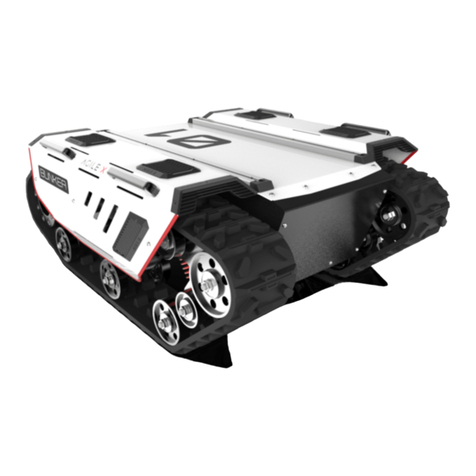
AgileX
AgileX BUNKER user manual
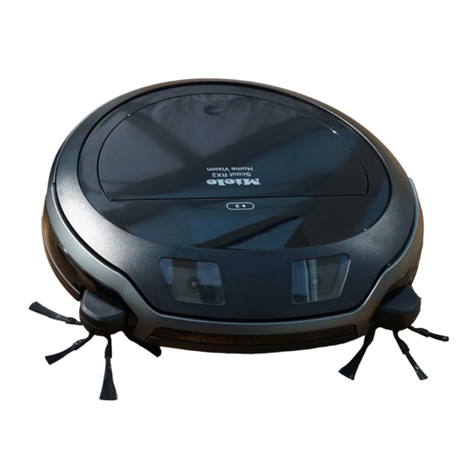
Miele
Miele HS18 operating instructions

Schmalz
Schmalz 3D-R quick start guide
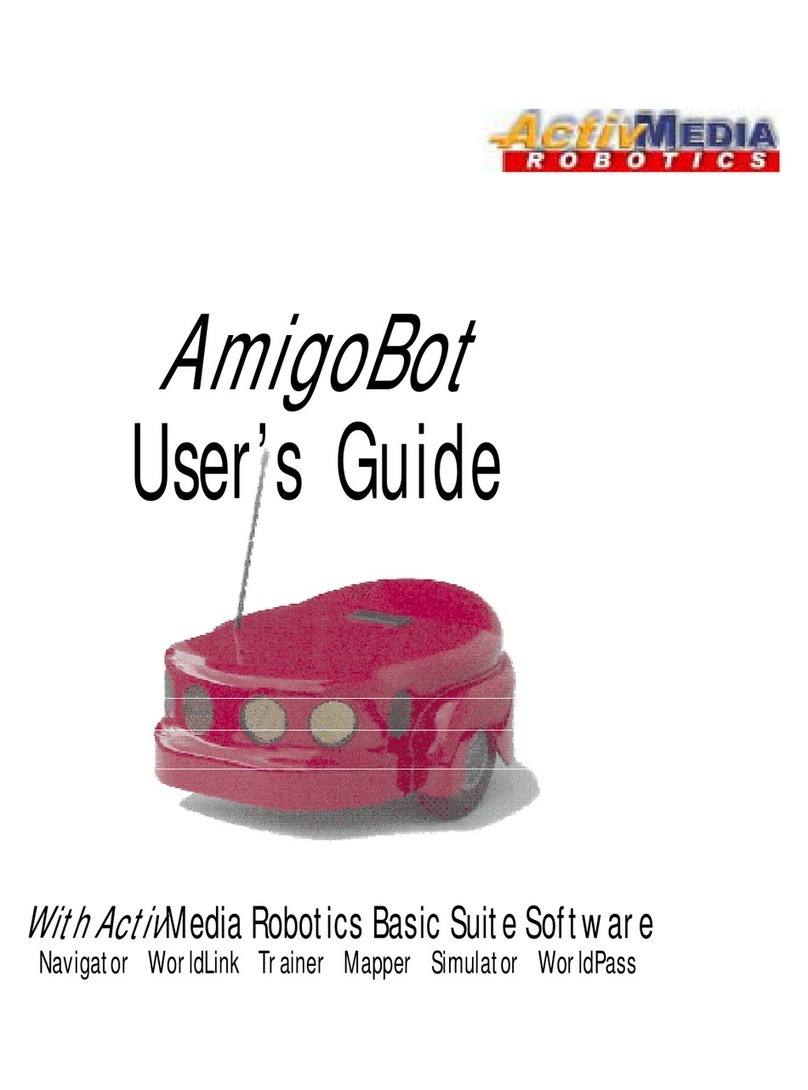
ActivMedia Robotics
ActivMedia Robotics AmigoBot user guide
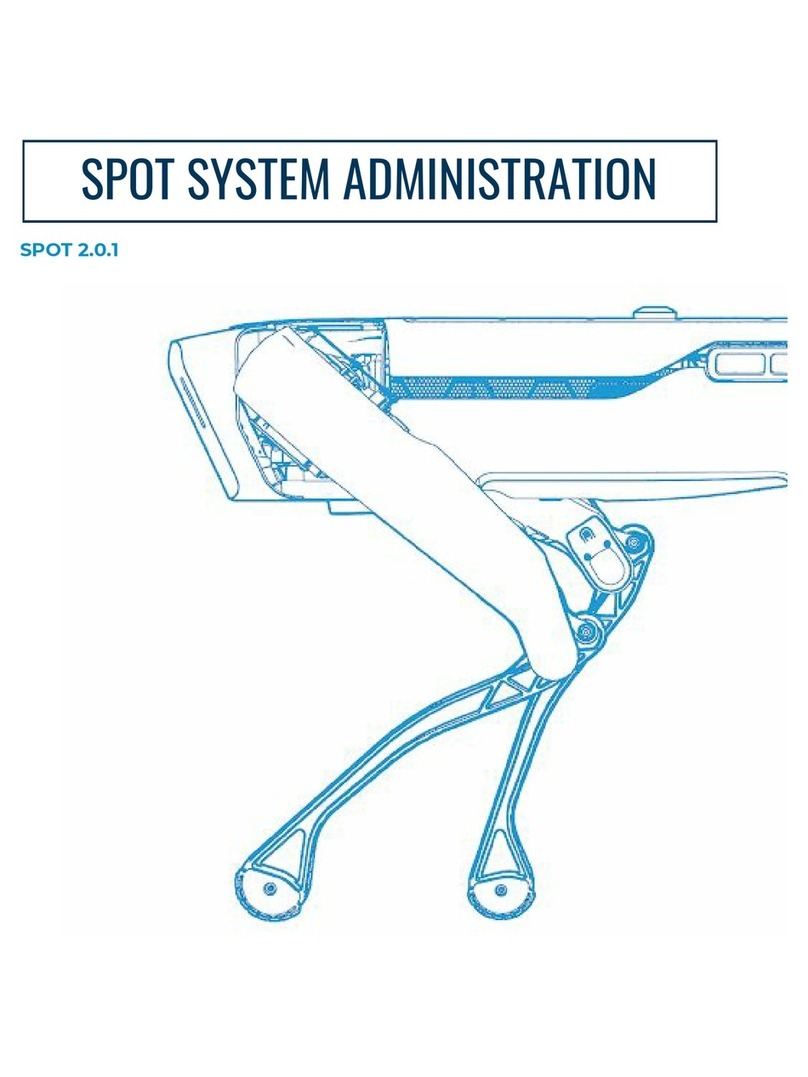
Boston Acoustics
Boston Acoustics SPOT SYSTEM ADMINISTRATION
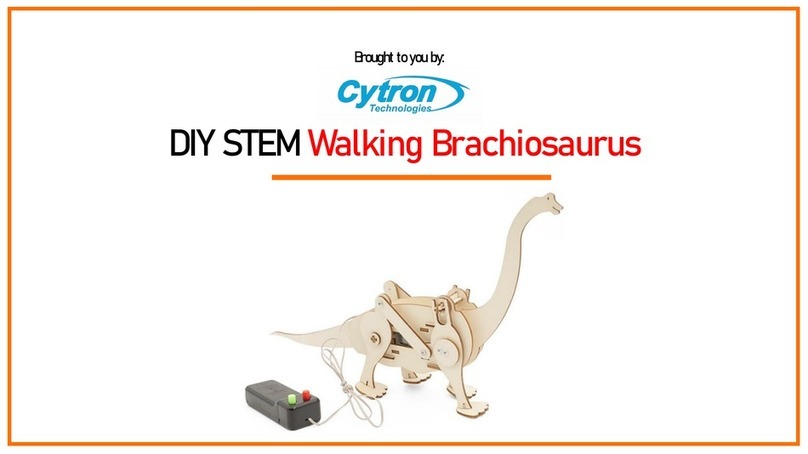
Cytron Technologies
Cytron Technologies Walking Brachiosaurus instruction manual
